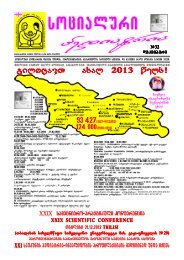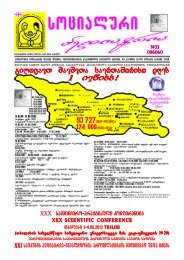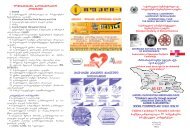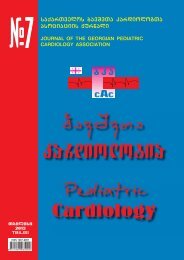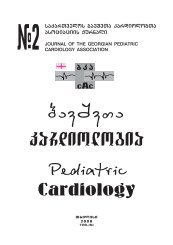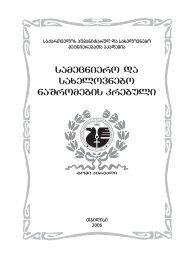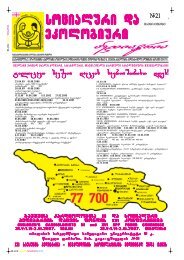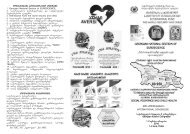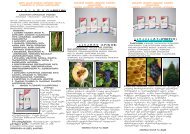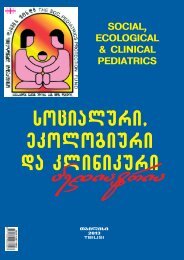Create successful ePaper yourself
Turn your PDF publications into a flip-book with our unique Google optimized e-Paper software.
32 ,fdidsf rfhlbjkjubf<br />
proBNP tests can be very useful for differentiation between<br />
physiological and pathological cardiac hypertrophy.<br />
Better knowledge of BNP behavior under physio-logical<br />
conditions should be useful for proper assessment of load<br />
in athletes as well as for correct interpretation of BNP<br />
results after physical exercise..<br />
Article<br />
Effect of Professional<br />
Exercises on BNP<br />
(Sheikhani Shahin et al.)<br />
Elevation of serum NTproBNP<br />
after exercise is<br />
an index of myocardial<br />
damage or cytoprotective<br />
reflection? (Faviou et al.)<br />
GDF-15, endoglin and<br />
NT-proBNP induction in<br />
athletes participating in<br />
an ultramarathon foot<br />
race. (Tchou et al.)<br />
Myocardial response to a<br />
triathlon in male athletes<br />
evaluated by Doppler tissue<br />
imaging and biochemical<br />
parameters<br />
(Leetmaa et al.)<br />
Myocardial Stress after<br />
Competitive Exercise in<br />
Professional Road Cyclists<br />
(Koning et al)<br />
Magnitude, Reproducibility,<br />
and Association<br />
With Baseline Cardiac<br />
Function of Cardiac<br />
Biomarker Release in<br />
Long-Distance Runners<br />
Aged ≥55 Years<br />
(Sahlen et al.)<br />
Effect of Competitive<br />
marathon cycling on<br />
plasma NT-proBNP and<br />
CTnT in healthy recreational<br />
cyclists (Neumayr<br />
et al.)<br />
Independent elevation<br />
of NT proBNP and<br />
cardiac troponins in endurance<br />
athletes after<br />
prolonged strenuous<br />
exercise (Scharhag et<br />
al.)<br />
Predisposing factors<br />
and consequences of<br />
elevated biomarker levels<br />
in long-distance<br />
runners aged >or=55<br />
years<br />
Biochemical and functional<br />
abnormalities of<br />
left and right ventricular<br />
function following ultra-endurance<br />
exercise<br />
(La Gerche et al.)<br />
Peptide<br />
BNP<br />
NT-proBNP<br />
NT-proBNP<br />
Pro-BNP<br />
BNP<br />
NT-proBNP<br />
NT-proBNP<br />
NT-proBNP<br />
NT-proBNP<br />
BNP<br />
Sports<br />
Football<br />
Volleyball<br />
Water Polo<br />
Bodybuilding<br />
-<br />
Ultramarathon<br />
Foot Race<br />
Triathlon<br />
Road Cycling<br />
Running<br />
Road Cycling<br />
Running marathon<br />
Mountain bike<br />
marathon<br />
Running<br />
Triathlon<br />
Pre-Training<br />
Concentration<br />
26.3 +/- 12.9<br />
19.1+/-11.8<br />
9.5 +/- 2.1<br />
12.0 +/- 5.9<br />
pg/ml<br />
-<br />
38.1+/-4.8 pg/ml<br />
7+/-2<br />
pmol/L<br />
47.5+/-37.5<br />
pg/ml<br />
42ng/L<br />
28+/-21 ng/L<br />
53ng/L<br />
12.2 etag/L<br />
Post-Training<br />
Concentration<br />
48.5+/- 18.4<br />
43.4+/- 30.6<br />
12.4 +/- 4.3<br />
15.7 +/- 5.6<br />
pg/ml<br />
58.37+/-19.48<br />
22.93+/-10.22<br />
ng/L<br />
1280.6 +/- 259.0<br />
pg/ml<br />
27+/-21<br />
pmol/L<br />
75.3 +/- 55.3<br />
pg/ml<br />
191ng/L<br />
278 +/- 152 ng/L<br />
Increased by:<br />
200ng/L<br />
97ng/L<br />
78ng/L<br />
121ng/L<br />
42.5 etag/L<br />
Article<br />
The impact of exercise duration<br />
and intensity on the release<br />
of cardiac biomarkers<br />
(Serrano-Ostariz et al.)<br />
Effect of short-term maximal<br />
exercise on BNP plasma<br />
levels in healthy individuals<br />
(Krupicka et al.)<br />
Peptide<br />
NT-proBNP<br />
BNP<br />
Sports<br />
Running<br />
Bicycle Spiroergometry<br />
Before TrainingConcentration<br />
21-32 ng/L<br />
19.4+/-2.5<br />
pg/ml<br />
Post-Training<br />
Concentration<br />
38-67 ng/L<br />
30.6+/-4.7<br />
pg/ml<br />
Table #1| BNP test results before and after exercise, as<br />
obtained by some authors. Note we do not add exercise<br />
duration time and time past after the exercise, when the<br />
blood samples were taken.<br />
It’s interesting that at least one published work states<br />
that the NT-proBNP test can be useful in senior endurance<br />
runners screening. Sahlen et al. published two articles<br />
related to the problem: “Predisposing factors and consequences<br />
of elevated biomarker levels in long-distance runners<br />
aged >or=55 years” (2009) and “Magnitude, re-producibility,<br />
and association with baseline cardiac function<br />
of cardiac biomarker release in long-distance run-ners<br />
aged > or =55 years” (2008). The aim of both studies was<br />
to assess the magnitude and reproducibility of biomarker<br />
release in athletes aged > or =55 years. One hundred<br />
eighty-five participants where included (61.1 +/- 5 years;<br />
29% women) at a 30-km cross-country race who were<br />
self-reportedly in excellent health. Before and after the<br />
race, the creatinine, N-terminal pro-brain natriuretic peptide<br />
(NT-proBNP), and troponin T were analyzed, and participation<br />
in the number of previous races and the race<br />
duration were recorded. NT-proBNP increased from 53<br />
ng/L (interquartile range 31 to 89) to 121 ng/L (interquartile<br />
range 79 to 184) and troponin T from undetectable to<br />
0.01 microg/L (interquartile range 0.01 to 0.04). The independent<br />
predictors of a large NT-proBNP increase were<br />
(1) greater levels present at baseline, (2) a greater increase<br />
in creatinine (both p




